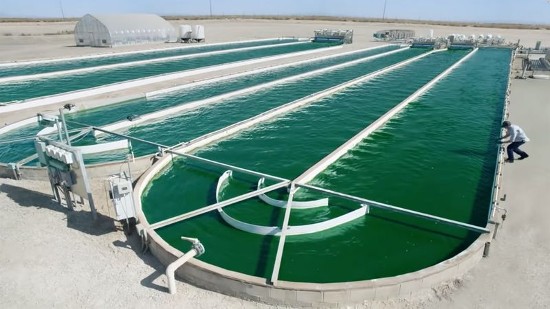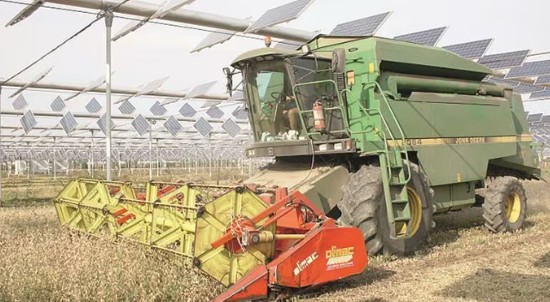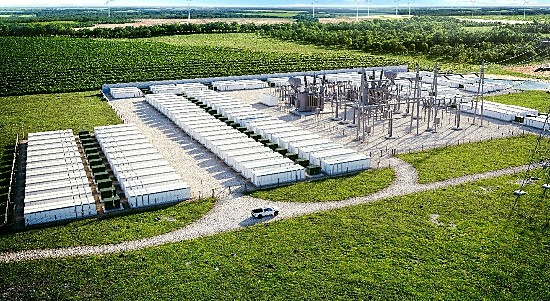Three stories that caught my eye in recent weeks related to the energy file. The first was an announcement from Exxon stating their commercial effort to produce biofuel from algae was being cancelled. The second describes a Remtec system using photovoltaic modules suspended over farmer’s fields to provide both energy and shade to optimize plant growth. The third is an announcement from NRStor with the launch of a 1,000-Megawatt-hour energy storage project in Ontario, to date the largest to be built in Canada.
Exxon Corporate Decision-Making Never Fails to Disappoint
My headline is stated from the perspective of an environmentalist who has watched Exxon through the years lie to the public or obfuscate facts known since the early 1970s that global warming was directly linked to the greenhouse gas (GHG) emissions from burning fossil fuels that the company continues to explore for and extract to this day. Of late, Exxon has promoted itself as green in its advertising to the public. But nothing can be farther from the truth.

In the latest Exxon move, the company which has advertised its work with environmentally-friendly fuel-from-algae projects (see image above) for the last ten years is walking away from Viridos Inc., of La Jolla, California, its technical partner since 2009. Viridos will continue to move forward but slashed 60% of its staff in late December to keep the lights on.
In addition, Exxon pulled its money from an algae project at the Colorado School of Mines after working with them in partnership for eight years. Add Exxon dropping its funding of a venture with the National Renewable Energy Laboratory and you begin to get a consistent picture. These projects looked good on the website promoting the oil giant as green, but one gets the feeling that the public continues to be sold a public relations bill of goods.
Algae into biofuel seems like a good investment because it allows Exxon to continue to produce fossil fuels but with only half the GHG emissions. And algae is better than ethanol-from-corn because it can be grown in brackish water and doesn’t take away land for staple food crop production.
Despite these perceived benefits the company has chosen to end its involvement in this and several other projects while emitting 630 million tons of GHGs from its operations just in the last year. Those GHG emissions total don’t accurately reflect the total damage to the environment Exxon is doing because tailpipe and chimney emissions aren’t included in the reported numbers.
In the last year, meanwhile, Exxon reported US $59 billion in profits assisted by a spike in fossil fuel prices from the fallout created by the Russian-Ukraine war. It appears, however, none of these profits can keep the company involved with its now former biofuel partners.
Agrivoltaics Combine Solar Panels with Farmer’s Fields
REM Tec is an Italian company that has designed a patented system of photovoltaic modules that can be incorporated into working farms without removing land from crop production. The panels seen in the picture below stand four metres in height and change position to ensure they can coexist with crops grown beneath.

A recent study done by the University of Piacenza tested 7,680 photovoltaic panels covering 11 hectares (approximately 27 acres) where corn, wheat, soybeans, lettuce, cabbage, endive and tomatoes were being grown. Not only did the fields yield millions of kilowatts of electricity, but they also produced higher crop yields per hectare than neighbouring ones without the panels. REM Tec has since added four additional agrivoltaic parks in Italy, one each in China and France, and two in Japan. Six more will be completed on farms in Portugal, Italy and France this year.
This technology can be used on farms without having solar panels compete for land with food crops. The agrivoltaics also reduce a farm’s dependency on grid-delivered electricity and can help reduce GHG emissions by replacing the use of diesel generators and by electrifying farm operations previously dependent on fossil fuel energy.
Canada to Build 1,000 Megawatt Battery Storage
This week NRStor Inc., a Canadian alternative energy provider based in Toronto, announced it was developing the Oneida Energy Storage Project, an energy storage facility that will produce up to a gigawatt-hour of power to feed to the grid using lithium-ion battery Megapacks from Tesla. This grid-balancing service is designed to draw surplus power from the grid during off-peak periods and release it back when energy demand peaks.
NRStor’s joint partner is the Six Nations of the Grand River Development Corporation. The facility should reduce the need for Ontario’s energy provider to use gas-fired power plants during peak demand periods and will help reduce GHG emissions by 4.1 million tons each year.
The Megapack is a commercial version of Tesla’s Powerwall, a smaller battery storage solution designed for individual homes. Each 3 Megawatt-hour unit contains an integrated battery stack, inverters, and thermal control systems, and is managed by Tesla’s proprietary software. When completed the site near Nanticoke, Ontario (see illustration below) will feature well over one hundred Megapacks. It is expected to be online by 2025.


















Cheap authorship:
“algae is better than ethanol-from-corn because it can be grown in brackish water and doesn’t take away land for staple food crop production.”
The food crop land as corn for ethanol is repeating an attack from big oil to kill biofuels.
The Pimentel study, which was funded by oil, was intended from its start to “prove” that biofuels could be killed by propaganda, by publishing a “study” that showed the worst possible assumptions you could make, show that it would be a bad way to get biofuels.
It was roundly and thoroughly attacked and debunked and disproven, yet even among environmentalists, it’s still repeated ad-nauseum as if alcohol biofuels can’t be produced economically.
No one with half a brain and any integrity ever thought of using food crop corn as stock for ethanol biofuels. Sure you could do it as an experiment, but no one who wasn’t trying to attack biofuels ever suggested doing in on industrial scale as if it would be a normal practice.
And so, decades later here we are hearing about it as if it were the only or preferred way.
Hi John, If corn is being grown on marginal agricultural land for biofuel production, it should be no problem. But the carbon budget allocation and greenhouse gas contributions needed to produce synfuel need to be accounted for. Algae to biofuel isn’t in competition with corn to biofuel. The products get produced in very different environments.